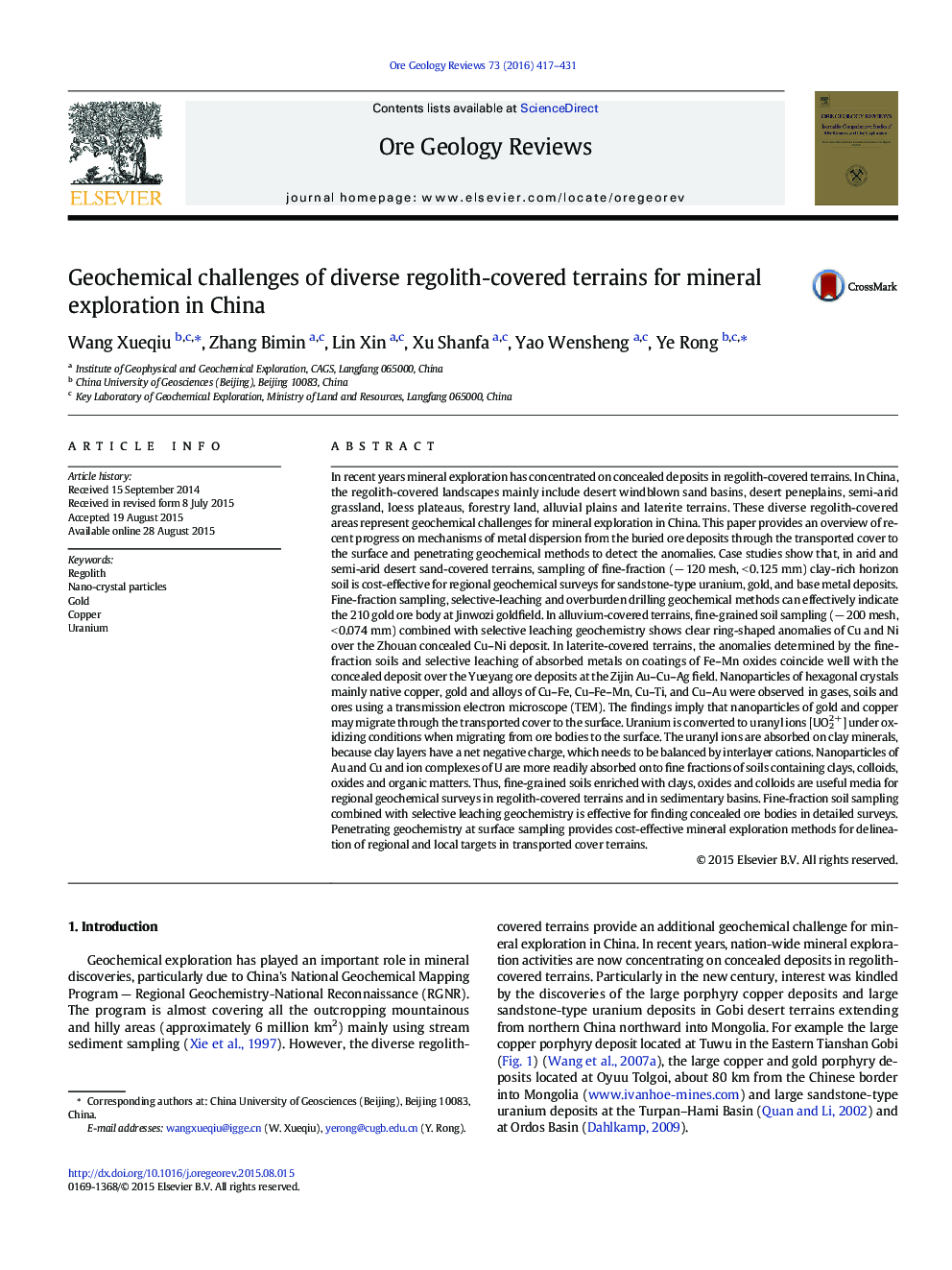| کد مقاله | کد نشریه | سال انتشار | مقاله انگلیسی | نسخه تمام متن |
|---|---|---|---|---|
| 4696934 | 1351857 | 2016 | 15 صفحه PDF | دانلود رایگان |
• Regolith-covered terrains in China are geochemical challenges for mineral exploration.
• Fine-fraction sampling and selective leaching are effective methods in covered areas.
• Nanoparticles of Au and Cu could migrate through the regolith cover to the surface.
• Complex ion of uranium under oxidation conditions migrates upward to the surface.
In recent years mineral exploration has concentrated on concealed deposits in regolith-covered terrains. In China, the regolith-covered landscapes mainly include desert windblown sand basins, desert peneplains, semi-arid grassland, loess plateaus, forestry land, alluvial plains and laterite terrains. These diverse regolith-covered areas represent geochemical challenges for mineral exploration in China. This paper provides an overview of recent progress on mechanisms of metal dispersion from the buried ore deposits through the transported cover to the surface and penetrating geochemical methods to detect the anomalies. Case studies show that, in arid and semi-arid desert sand-covered terrains, sampling of fine-fraction (− 120 mesh, < 0.125 mm) clay-rich horizon soil is cost-effective for regional geochemical surveys for sandstone-type uranium, gold, and base metal deposits. Fine-fraction sampling, selective-leaching and overburden drilling geochemical methods can effectively indicate the 210 gold ore body at Jinwozi goldfield. In alluvium-covered terrains, fine-grained soil sampling (− 200 mesh, < 0.074 mm) combined with selective leaching geochemistry shows clear ring-shaped anomalies of Cu and Ni over the Zhouan concealed Cu–Ni deposit. In laterite-covered terrains, the anomalies determined by the fine-fraction soils and selective leaching of absorbed metals on coatings of Fe–Mn oxides coincide well with the concealed deposit over the Yueyang ore deposits at the Zijin Au–Cu–Ag field. Nanoparticles of hexagonal crystals mainly native copper, gold and alloys of Cu–Fe, Cu–Fe–Mn, Cu–Ti, and Cu–Au were observed in gases, soils and ores using a transmission electron microscope (TEM). The findings imply that nanoparticles of gold and copper may migrate through the transported cover to the surface. Uranium is converted to uranyl ions [UO22 +] under oxidizing conditions when migrating from ore bodies to the surface. The uranyl ions are absorbed on clay minerals, because clay layers have a net negative charge, which needs to be balanced by interlayer cations. Nanoparticles of Au and Cu and ion complexes of U are more readily absorbed onto fine fractions of soils containing clays, colloids, oxides and organic matters. Thus, fine-grained soils enriched with clays, oxides and colloids are useful media for regional geochemical surveys in regolith-covered terrains and in sedimentary basins. Fine-fraction soil sampling combined with selective leaching geochemistry is effective for finding concealed ore bodies in detailed surveys. Penetrating geochemistry at surface sampling provides cost-effective mineral exploration methods for delineation of regional and local targets in transported cover terrains.
Journal: Ore Geology Reviews - Volume 73, Part 3, March 2016, Pages 417–431
